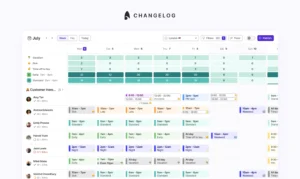
The guide for call centre staffing | Free call centre staffing plan template

Staffing levels play a pivotal role in call centre operations. They balance demand and supply, although often considered a part of the forecasting process.
Despite the integral role of technology in call centres, a significant portion of operating costs—upwards of 70%—is allocated to human resources.
Therefore staffing level optimisation is a major area of focus for the call centre’s performance.
In this blog, learn everything about the call centre staffing model, how to build one, tips to improve call centre staffing and the utilisation of Erlang C to plan call centre staffing.
What is a call centre staffing model?

A call centre staffing model is a framework to align surfer (or agent) supply with call volume by considering intervals, types of surfers, after-call work (ACW), and mandatory breaks. Its goal is to meet the required service level while efficiently managing staffing needs based on call volumes.
Creating a call centre staffing plan is an essential early-stage task for any call centre. Call centre staffing models mainly need decisions in these four areas;
- the number of incoming calls,
- the necessary number of surfers to handle these calls,
- shift starting times for the operations, and
- the number of surfers to be allocated to each shift.
In handling inbound calls, the Erlang C formula is a commonly used staffing model for call centres. However, for complex operations involving multiple skills and communication channels like email, accurate staffing evaluations require advanced techniques like simulation.
How to build a call centre staffing model?
Call centres are complex systems in which technology and human behaviour play important roles.
For the staffing model to be relevant, it should contain all crucial system elements. The Erlang C model has almost all essential features, including,
- Random service duration (which includes talk time and wrap-up time);
- A fixed number of undistinguishable surfers (meaning that all surfers are, statistically speaking, equally fast);
- All calls wait in the queue until they get served (thus, no abandonments);
- Calls are answered in order of arrival; thus, the longest-waiting call is first.
The system focuses on the following:
- Number of incoming calls: The total number of calls a call centre receives within a specific timeframe.
- Time period: The duration or specific interval during which call centre metrics and activities are measured or analysed.
- Call arrival rate: The average rate at which calls arrive at a call centre, usually measured as the number of calls per unit of time.
- Traffic intensity: A measure of the load or volume of calls compared to the capacity of the call centre, calculated by dividing the call arrival rate by the average handling time.
- Average surfer occupancy: The percentage of time call centre surfers spend handling customer interactions compared to their available working time.
- Probability of waiting: The likelihood that a caller will have to wait in a queue before reaching a surfer, based on call arrival rate and surfer capacity.
- Average speed of answer (ASA): The average time it takes for a call centre surfer to answer a customer’s call, calculated by dividing the total wait time for all answered calls by the number of answered calls.
- Service level (SLA): The predetermined target or agreement between a call centre and its customers regarding the acceptable waiting time or response time for calls to be answered or resolved.
The easy answer to your question “how to create a call centre staffing model” will be to get your hand on the call centre staffing formula. The formula can be accessed via the call centre staffing model Excel template or calculators present online on websites.
Additional factors in creating a staffing model
Here is a list of additional factors to include while creating a call centre staffing model.
- Abandonment rate: The percentage of callers who hang up or disconnect before reaching a surfer indicates the effectiveness of call handling and customer service. It is calculated by dividing the number of abandoned calls by the total number of incoming calls.
- Attrition rate: The rate at which employees leave a company over a specific period, usually expressed as a percentage. It helps measure employee turnover and can indicate job satisfaction, company culture, or employee engagement.
- Shrinkage: The percentage of time surfers are unavailable to handle calls due to breaks, training, meetings, or other non-productive activities. It accounts for the difference between scheduled and actual working time.
- Call arrival pattern: The distribution and timing of incoming calls to a call centre over a given period. Analysing call arrival patterns help with staffing and resource allocation to ensure adequate surfer coverage during peak and off-peak periods.
- Forecast accuracy: The measure of how accurately predicted call volumes and other contact centre metrics align with the actual values. It helps assess the effectiveness of forecasting methods and assists in staffing and scheduling decisions.
- Surfer availability: The proportion of time when surfers are available to handle customer interactions. It considers factors like breaks, absence, and unproductive time and is calculated by dividing the available working time by the total working time.
- Desired wait time: The targeted or expected time a caller should wait in the queue before connecting with a surfer. It is determined based on service level agreements and customer expectations and is a key metric for customer satisfaction.
- Skills-based routing: A call routing strategy that directs incoming calls to the most suitable and available surfers based on their specific skills, expertise, and qualifications. It ensures customers are connected to surfers who can best address their needs, improving efficiency and customer experience.
Using Erlang C to plan call centre staffing
Erlang C is a calculation method that estimates the wait time for callers to be connected to a human in a call centre or similar setting.
Here’s an example to understand how Erlang C works.
Incoming contacts: 400
Period: 30 minutes
Average handling time (AHT): 257 seconds
Required service level: 80%
Target answer time: 20 seconds
The result of the Erlang C calculation:
The number of surfers needed is 97, considering a 30% shrinkage (70 surfers before shrinkage).
This staffing level achieves a service level of 95.3%, meaning 95.3% of calls will be answered within 20 seconds.
The average speed of answer (ASA) is 2.6 seconds, indicating the average time it takes for calls to be answered.
As the number of surfers increases, the ASA and delay decrease.
The below graphs depict;
(i) The relationship between the number of surfers, delay profitability, and service level in the Erlang C model.
(ii) The relationship between the number of surfers and average waiting time in the Erlang C model.
Tips to improve call centre staffing
Improving call centre staffing ensures customer satisfaction, maximises efficiency, and achieves business goals. Here are some tips to help you improve your staffing model for call centres:
- Adequate hiring and training: Focus on hiring individuals with strong communication skills, empathy, and problem-solving abilities. Implement a comprehensive training programme to equip your staff with the knowledge and skills to handle customer enquiries effectively.
- Utilise workforce management software: Invest in a workforce management system to help you accurately forecast call volume and schedule staff accordingly. This software can optimise staffing levels based on historical data, call patterns, and other relevant factors.
- Implement flexible scheduling options: Consider offering flexible scheduling options to accommodate different employee preferences and improve morale. This can include shift swapping, part-time or remote work arrangements, and flexible break times.
- Monitor and analyse call data: Identify patterns, common customer issues, and peak call times by analysing call data. Use this information to adjust staffing levels and allocate resources more efficiently.
- Implement performance metrics: Define KPIs like average handling time, first call resolution rate, and customer satisfaction scores. Regularly monitor these metrics and provide feedback to employees to encourage continuous improvement.
Start your call centre staffing plan with Surfboard
Surfboard can help you with your call centre staffing plan. Surfboard is a scheduling software that simplifies the scheduling process, supporting more flexible working patterns and allowing you to easily plan shifts and rotations across different time zones.
If you’re just getting started, you can use Surfboard’s free call centre staffing calculator to help determine the number of surfers needed to handle call volumes effectively.
For those already on board, Surfboard’s integrated call centre forecasting features enables you to anticipate future call patterns and proactively plan and adjust your staffing levels.
Using Surfboard, Bloom & Wild, a D2C flower delivery company, increased its forecasting performance by 33%. Surfboard provided Bloom & Wild with the ability to provide outsourcing agencies advanced notice of staffing requirements, ensuring both parties are well-equipped to handle peak times and special occasions.
Read the entire case study here and book a demo to know more about our platform.
FAQs
How should one go about writing a staffing plan for call centres?
When writing a staffing plan for call centres, consider the following key points:
- Understand the call centre’s goals and objectives.
- Analyse historical call data.
- Determine service level objectives.
- Calculate staffing requirements (utilise call centre staffing model Excel template)
- Shrinkage factor.
- Plan for flexibility.
- Monitor and adjust the plan.
- Consider additional factors.
- Document the plan.
- Continuously improve the plan.
How can one improve call centre staffing?
After downloading the call centre staffing model template, consider the following strategies to improve call centre staffing:
- Optimise
- Provide comprehensive training programmes.
- Foster a positive work environment.
- Implement performance management systems.
- Use workforce management software.
- Implement flexible scheduling options.
- Address attrition and retention challenges.
Why should one choose the template provided by Surfboard for a call centre staffing plan?
Here are some reasons why choosing a template for a call centre staffing plan can be beneficial:
- Provides a structured format with predefined sections and placeholders.
- Designed based on industry best practices and expertise.
- Covers essential components of a staffing plan, ensuring that you address all the critical areas.
- Maintain a unified approach, making comparing and analysing different call centres or periods easier.
- You can adapt the template to fit your call centre’s goals, metrics, and operational requirements.



